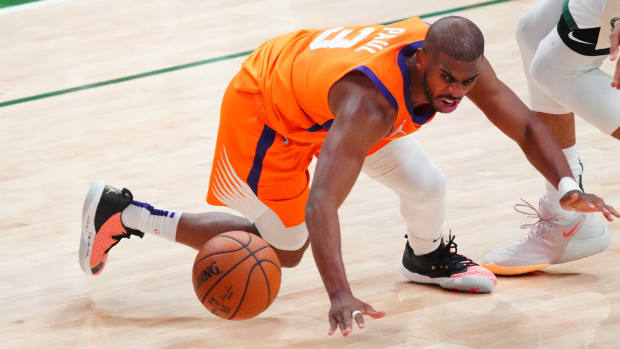If Phoenix is going to regain control of this series, Paul has to regain control of the ball.
Welcome to the Morning Shootaround, where every weekday you’ll get a fresh, topical column from one of SI.com’s NBA writers: Howard Beck on Mondays, Chris Mannix on Tuesdays, Michael Pina on Wednesdays, Chris Herring on Thursdays and Rohan Nadkarni on Fridays.
In the second round of the 2014 playoffs, in what was arguably the nadir of his playoff career, Chris Paul had two massive turnovers down the stretch of a pivotal Game 5 against the Thunder, helping the Clippers turn a 104–97 lead with 49.2 seconds to go into a shocking 105–104 loss.
First, with a 104–102 lead and under 20 seconds to go, Paul simply had to wait to be intentionally fouled while dribbling up the floor. Instead, sensing the impending contact, Paul seemingly tried to draw a shooting foul in the backcourt, jumping while Russell Westbrook approached him. Except the foul never came, Westbrook knocked the ball away and the Thunder corralled it in a scramble. OKC then took a one-point lead on three free throws, and on the game’s last (and ensuing) possession, Paul drove into the paint with a chance to take the game-winner, but after a moment of hesitation, fumbled the ball before ever getting a shot up.
It was hard not to be reminded of this sequence after Game 4 of the NBA Finals. Paul finished the Suns’ most recent loss in the series with five turnovers, including two regrettable ones in the fourth. First, with Phoenix leading 95–92 with just under four minutes to play, Paul was doubled after a pick-and-roll, and his pass back to Deandre Ayton was intercepted by Giannis Antetokounmpo, who would score on the resulting fast break. (This was also the play that should have resulted in Devin Booker’s sixth foul, so it was nearly a triple whammy.) And finally, with the Suns' trailing 101–99 and a chance to get a two-for-one, Paul attempted a crossover in front of Giannis and lost the ball, leading to another fast-break score for Milwaukee. (And somehow, yet another play that probably should have been a foul on Booker.)
It’s normal for most perimeter players who handle the ball nearly the whole game to rack up turnovers. It’s a tradeoff practically every NBA team lives with in exchange for playmaking and the pressure pick-and-rolls apply on defenses. Except it’s not normal for Paul. In the last three games of the Finals, CP3 has amassed a whopping 15 turnovers. That’s more than he had in the eight games he played in Rounds 2 and 3 (13) combined. In six games in the first round against the Lakers, even with his injured shoulder, Paul had only nine turnovers against one of the best defenses from the regular season. He’s currently averaging 4.3 giveaways a game during the Finals after averaging no more than two during any previous round and only 2.2 a night during the regular season.

A unique aspect of CP’s brilliance has always been how his effectiveness doesn’t come at the cost of efficiency. In his big scoring nights from the postseason—his 37-point closeout against the Nuggets, his 41-point closeout vs. the Clippers and his 32-point opener in the Finals—he turned the ball over only four times total, including zero turnovers in Game 6 of the West Finals.
So what’s happening against Milwaukee?
Of Paul’s 15 turnovers over Games 2–4, 12 can be classified as bad passes. Many of the miscues are coming when Paul can’t break down the defense after a screen, and instead tries a last-second pass, only for a defender to be waiting in the lane, a teammate not to be ready or the ball to miss its target entirely.
The Bucks' defense deserves a lion’s share of the credit for the uncharacteristic mistakes from Paul. After mostly ditching their switching scheme, Milwaukee isn’t letting Phoenix’s guards dictate the matchups they want to see in the half court. In Game 1, Paul essentially invited the Bucks’ bigs into space and made them pay. Since then, he’s been hounded by Jrue Holiday, and when he comes off a screen, Paul is being boxed by two lengthy defenders, and Milwaukee has the smarts and high level of execution required to scramble around everyone else.
Holiday especially seems to be bothering Paul by picking him up full-court on nearly every possession. For all his offensive struggles in the Finals, Holiday has been worth every draft pick traded away on the other end of the floor, becoming perhaps the first player all postseason to make the Suns look even mildly discomforted when entering a pick-and-roll.
Another factor could be health. Paul won’t use this crutch, but not only did he suffer that shoulder injury in Round 1, he revealed after the Clippers series he was playing with torn ligaments in his right hand. That wouldn’t necessarily explain all the bad passes, but it could explain why Paul never really looked comfortable dribbling in Game 4, and why he let others initiate sets for parts of the night. CP3 didn’t only have five turnovers against the Bucks on Wednesday; he also recorded his fewest points and assists of the series, with his worst shooting effort to boot.
Paul obviously isn’t a choker or some kind of meltdown artist. Those narratives may have emerged after the Thunder loss seven years ago, but CP put those questions to rest this year after providing several big moments during this run for the Suns. If anything, his struggles are particularly shocking considering how well he’s played this postseason up until this point. Whatever the ultimate reason is for this recent blip, if Phoenix is going to regain control of this series, Paul has to regain control of the ball.
More NBA Coverage:
• Inside the Block That Helped the Bucks Win Game 4
• Bobby Portis Is the Bucks' Unsung Hero
• Milwaukee's Defense Was Built for This Moment